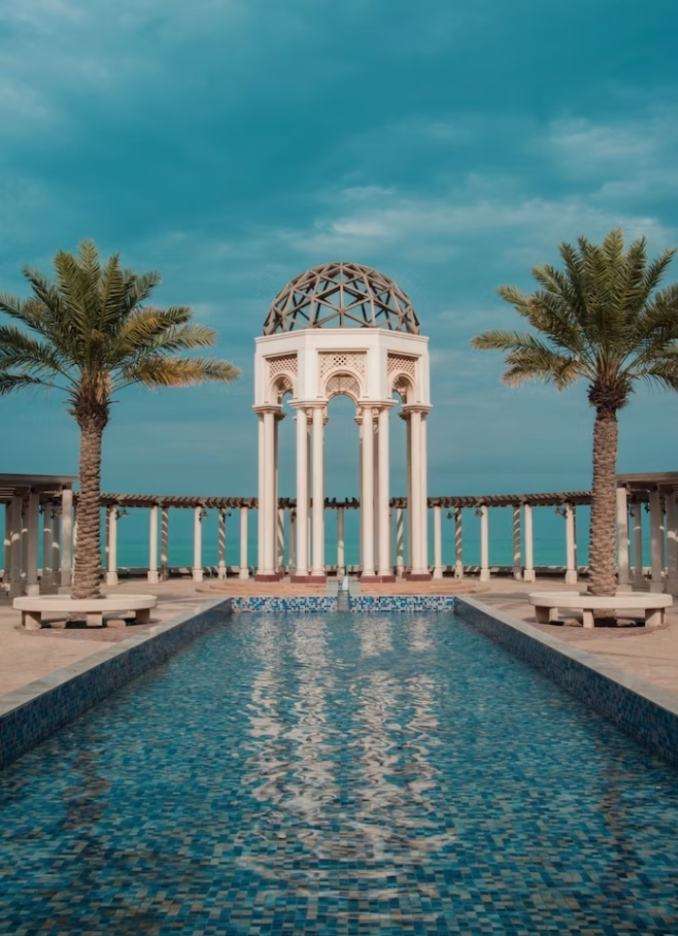Abu Dhabi, the capital of the United Arab Emirates, is renowned for its stunning skyline, luxurious amenities, and cultural attractions. However, for those seeking a more adventurous and budget-friendly experience, the city also offers fantastic opportunities for free camping. Unveiling the camping spots in Abu Dhabi, this article will guide you to some of the best spots where you can camp for free and connect with nature.
Contents
Umm Al Emarat Park:
Umm Al Emarat Park, formerly known as Mushrif Central Park, is a captivating urban green space nestled in the heart of Abu Dhabi. Renamed in honor of Her Highness Sheikha Fatima bint Mubarak, also known as “Umm Al Emarat” or the Mother of the Nation, the park spans approximately 22 hectares, offering a diverse range of recreational activities and natural attractions.
Features and Attractions:
Botanic Garden: Umm Al Emarat Park boasts a meticulously curated botanic garden that showcases a rich variety of plant species, including indigenous flora. Visitors can embark on a leisurely stroll through themed garden areas, each highlighting the diverse ecosystems of the region.
Children’s Garden: Families with children can explore the dedicated Children’s Garden, featuring interactive play areas, educational exhibits, and a whimsical splash pad. The design encourages learning through play and fosters a connection with nature from a young age.
Amphitheater: The park’s amphitheater serves as a hub for cultural events, concerts, and community gatherings. Its design harmonizes with the park’s natural surroundings, creating an atmospheric venue for entertainment and relaxation.
Animal Barn: Animal enthusiasts can visit the Animal Barn, where they can observe and learn about various farm animals. The interactive experience is designed to educate visitors about the importance of animal welfare and sustainable practices.
Lake and Sustainability Features: A central lake, sustainably sourced with treated wastewater, enhances the park’s ecological balance. Sustainable practices, such as water recycling and energy-efficient technologies, contribute to Umm Al Emarat Park’s commitment to environmental responsibility.

Location:
Umm Al Emarat Park is conveniently situated in the Mushrif area of Abu Dhabi, providing easy access to residents and visitors alike. The park’s exact location is at 15th Street, Mushrif, Abu Dhabi, United Arab Emirates. The central location makes it a popular destination for individuals seeking a serene escape within the city limits.
Visiting Information:
Opening Hours: Umm Al Emarat Park is generally open to the public seven days a week. Check the official website or contact the park administration for specific opening hours and any special events.
Entrance Fee: While entry to the park is typically free, certain attractions and activities within the park may have individual admission fees. Visitors are encouraged to check the park’s official website for the latest information on fees and offerings.
Whether you’re looking for a peaceful retreat, a family-friendly outing, or a cultural experience, Umm Al Emarat Park stands as a testament to Abu Dhabi’s commitment to blending nature, education, and community engagement in a harmonious urban settingLiwa Desert: A Tranquil Sea of Sand in Abu Dhabi
Liwa Desert:

The Liwa Desert, also known as the Rub’ al Khali or the Empty Quarter, is a vast expanse of sand dunes that stretches across the southern part of the Arabian Peninsula. Located in the Emirate of Abu Dhabi, the Liwa Desert is renowned for its mesmerizing landscapes, towering dunes, and its significance as one of the world’s largest uninterrupted sand deserts.
Key Features:
Sand Dunes: The Liwa Desert is characterized by colossal sand dunes that can reach heights of up to 250 meters (820 feet). The ever-shifting sands create a dynamic and breathtaking terrain, making it a paradise for desert enthusiasts, photographers, and adventure seekers.
Qasr Al Sarab Desert Resort: Nestled amidst the dunes, the Qasr Al Sarab Desert Resort offers a luxurious oasis in the heart of the Liwa Desert. Visitors can experience the tranquility of the desert while enjoying world-class accommodations, spa facilities, and unparalleled views of the surrounding landscape.
Moreeb Dune: Known as the “Scary Mountain,” Moreeb Dune is one of the tallest sand dunes in the Liwa Desert. It is famous for hosting the Moreeb Dune Festival, an annual event that includes thrilling desert competitions such as the Moreeb Hill Climb.
Liwa Oasis: At the northern edge of the Liwa Desert, the Liwa Oasis provides a contrast to the arid landscape with date palm groves and traditional settlements. The oasis is a cultural and historical gem, showcasing the resilience of life in the desert.
Exact Location:
The Liwa Desert is situated in the southern part of the Emirate of Abu Dhabi, United Arab Emirates. The approximate coordinates for the central area of the Liwa Desert are around 23.1142° N latitude and 53.7737° E longitude. Access to the desert is typically through the town of Liwa, which serves as a gateway to the vast sand dunes.
Visiting Information:
Traveling to Liwa: The journey to the Liwa Desert involves a road trip from Abu Dhabi, with Liwa town as the starting point. The drive offers picturesque views of the desert landscape, and visitors can explore the dunes by car or participate in organized desert safaris.
Climate and Timing: Due to the extreme temperatures, it is advisable to visit the Liwa Desert during the cooler months, typically from October to March. Mornings and evenings are ideal for experiencing the desert’s beauty and avoiding the intense midday heat.
Permits and Regulations: While some areas of the Liwa Desert are accessible to the public, certain sections may require permits, especially if camping overnight. Check with local authorities or tour operators for the latest information on permits and regulations.
The Liwa Desert stands as a testament to the awe-inspiring beauty of nature, inviting visitors to explore its vast sea of sand, experience traditional desert life, and witness the grandeur of the Arabian Peninsula’s most iconic desert landscape.
Mangrove National Park:
Mangrove National Park, located in the vibrant city of Abu Dhabi, is a unique natural sanctuary that seamlessly blends the beauty of mangrove forests with the urban landscape. Positioned along the coast, this protected area showcases the ecological significance of mangroves while offering visitors a serene escape within the city limit.
Key Features:
Mangrove Ecosystems: The park is home to extensive mangrove ecosystems, providing a habitat for diverse marine life, birds, and plant species. Visitors can explore the intricate network of mangrove channels by boat, kayak, or on guided nature walks.
Biodiversity: Mangrove National Park is a haven for biodiversity. The mangrove forests serve as nurseries for fish and other marine organisms, making it a crucial area for the conservation of coastal ecosystems. Birdwatchers will also appreciate the variety of avian species that inhabit or migrate through the park.
Educational Facilities: The park features educational centers and interpretive displays that offer insights into the importance of mangrove ecosystems, the wildlife they support, and the conservation efforts in place. These resources make it an excellent destination for environmental education and awareness.
Abu Dhabi Mangrove Kayaking Tours: One of the popular activities in the park is kayaking through the mangrove channels. Several tour operators offer guided kayaking tours, allowing visitors to paddle through the peaceful waterways and observe the unique flora and fauna up close.
Exact Location:
Mangrove National Park is located along the shoreline of Abu Dhabi, specifically on the eastern side of the city. The park’s approximate coordinates are around 24.4779° N latitude and 54.3954° E longitude. Access to the park is facilitated by well-maintained pathways, and various entry points allow visitors to explore different sections of the mangrove forests.
Visiting Information:
Entrance Fee: While there may be a nominal fee for certain activities or tours, access to the park itself is often free of charge.
Visitor Centers: The park has visitor centers equipped with information on guided tours, wildlife, and the significance of mangrove conservation. Knowledgeable staff members are available to assist visitors and provide educational materials.
Guided Tours: To enhance the experience, consider joining guided tours or eco-friendly activities offered by authorized operators within the park. These tours often provide a deeper understanding of the mangrove ecosystem and its importance.
Conservation Awareness: Visitors are encouraged to be environmentally conscious during their visit, respecting the delicate balance of the mangrove ecosystem. Follow any guidelines provided to ensure the preservation of this unique natural treasure.
Mangrove National Park stands as a testament to Abu Dhabi’s commitment to conservation, offering a harmonious blend of urban development and the preservation of valuable natural habitats. Whether you’re seeking a tranquil escape, educational exploration, or an adventure through the mangrove channels, the park provides a unique and enriching experience within the heart of the city.
Jebel Hafeet:one of best camping spots in abu dhabi

Jebel Hafeet, standing proudly as the second-highest peak in the United Arab Emirates, is a majestic mountain range located near the city of Al Ain in Abu Dhabi. Revered for its stunning natural beauty and panoramic vistas, Jebel Hafeet has become a popular destination for both nature enthusiasts and adventure seekers.
Key Features:
Elevation and Landscape: Jebel Hafeet reaches an impressive height of 1,240 meters (4,068 feet) above sea level, providing visitors with breathtaking views of the surrounding desert landscape. The mountain is characterized by rugged slopes, rocky terrain, and winding roads leading to its summit.
Scenic Drive: The journey to the top of Jebel Hafeet is an adventure in itself. The winding road leading to the summit is renowned for its challenging hairpin turns and offers spectacular views at every twist and turn. The drive has become a favorite among car enthusiasts and cyclists, providing an exhilarating ascent through the mountainous terrain.
Jebel Hafeet Hot Springs: At the foothills of the mountain, visitors can discover the Jebel Hafeet Hot Springs. The natural hot water springs are believed to have therapeutic properties, attracting those seeking relaxation amid the mountain’s serene surroundings.
Green Mubazzarah Park: Situated at the base of Jebel Hafeet, Green Mubazzarah Park is a verdant oasis with well-maintained lawns and hot spring pools. It serves as a popular picnic spot and offers a contrast to the arid landscape of the mountain.
Exact Location:
Jebel Hafeet is located on the outskirts of Al Ain, a city in the Emirate of Abu Dhabi. The mountain is situated along the border between the United Arab Emirates and Oman. The precise coordinates for the summit of Jebel Hafeet are approximately 24.0816° N latitude and 55.7689° E longitude.
Visiting Information:
Accessibility: Al Ain is the nearest city to Jebel Hafeet, and the mountain is easily accessible by road. The scenic drive to the summit takes approximately 45 minutes to an hour, depending on traffic and stops along the way.
Summit Facilities: At the summit, visitors will find an impressive viewing platform, allowing for 360-degree views of the surrounding landscapes. There are also facilities such as cafes, rest areas, and souvenir shops for visitors to enjoy.
Jebel Hafeet stands as a natural wonder, offering a captivating blend of adventure, scenic beauty, and a respite from the desert plains. Whether you’re a nature enthusiast, a thrill-seeker, or someone seeking tranquility, a visit to Jebel Hafeet promises a memorable experience amidst the heights of Abu Dhabi.
Al Wathba Fossil Dunes: A Geological Marvel in Abu Dhabi
Al Wathba Fossil Dunes, situated on the outskirts of Abu Dhabi, is a unique natural wonder that unveils the geological history of the region. Comprising ancient sand dunes that have solidified over time, the site offers visitors a captivating glimpse into the prehistoric landscapes that once dominated the area.
Key Features:
Fossilized Dunes: The defining feature of Al Wathba is its fossilized sand dunes, which have undergone a process of lithification, transforming loose sand into solid rock over thousands of years. These dunes, frozen in time, reveal intricate patterns and textures that tell the story of ancient wind and sand dynamics.
Scenic Beauty: The dunes at Al Wathba create a mesmerizing landscape, with undulating curves and intricate formations. The site is a haven for photography enthusiasts, offering stunning vistas especially during sunrise and sunset when the play of light accentuates the dunes’ textures.
Accessibility: Al Wathba Fossil Dunes are easily accessible by road from Abu Dhabi. The site is relatively undeveloped, providing a raw and authentic desert experience. Visitors can explore the dunes on foot, capturing the beauty of the natural surroundings.
Educational Significance: The fossilized dunes are not only a visual spectacle but also hold scientific importance. Researchers and geologists are drawn to Al Wathba to study the preserved patterns and layers, gaining insights into the climatic and environmental conditions of the past.
Exact Location:
Al Wathba Fossil Dunes are located southeast of Abu Dhabi city, near the town of Al Wathba. The approximate coordinates for the central area of the fossilized dunes are around 24.1304° N latitude and 54.6795° E longitude. Access to the site is primarily through the E30 highway, and local maps or GPS navigation can guide visitors to the precise location.
Visiting Information:
Timing: The site is accessible throughout the year, but the cooler months, from October to March, are recommended for a more comfortable outdoor experience.
Precautions: As the area is undeveloped, visitors should take necessary precautions, such as carrying sufficient water, wearing appropriate footwear, and being mindful of the fragile ecosystem.
Environmental Conservation: Al Wathba Fossil Dunes are a protected natural site, and visitors are encouraged to follow Leave No Trace principles, leaving the dunes as they found them to preserve the integrity of this unique desert environment.
A visit to Al Wathba Fossil Dunes promises a journey through time, allowing explorers to connect with the ancient geological history of Abu Dhabi while immersing themselves in the tranquility of this untouched desert landscape.
conclusion
Before embarking on your camping adventure, it’s essential to check local regulations, obtain any necessary permits, and respect the environment. By embracing the free camping options in Abu Dhabi, you can create unforgettable memories while experiencing the diverse landscapes that this vibrant city has to offer. So, pack your camping gear, and get ready to explore the hidden treasures of Abu Dhabi without breaking the bank.
I’m originally from Manchester (England) but I currently live in New York. I started this travel blog all the way back in 2009 to provide travel advice that wasn’t available in the guidebooks.
Since then I’ve traveled to over 60 countries, a lot of the time, solo. My site is filled with destination guides, things to do, epic itineraries and money-saving travel tips. I hope I can inspire you to see the world!






